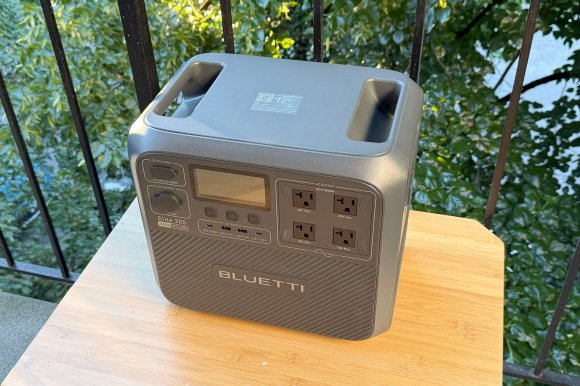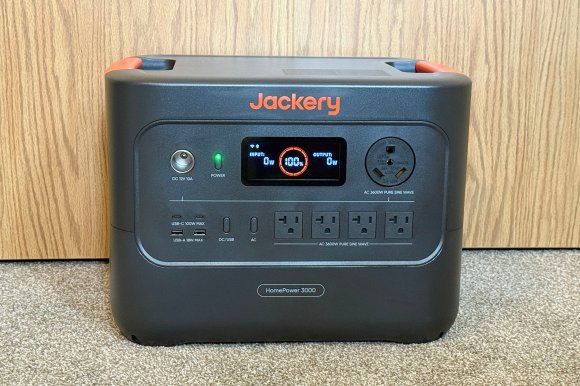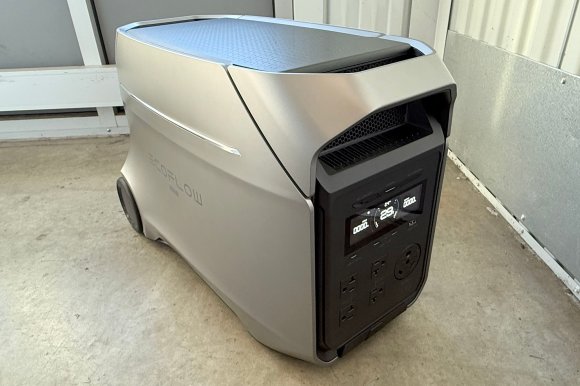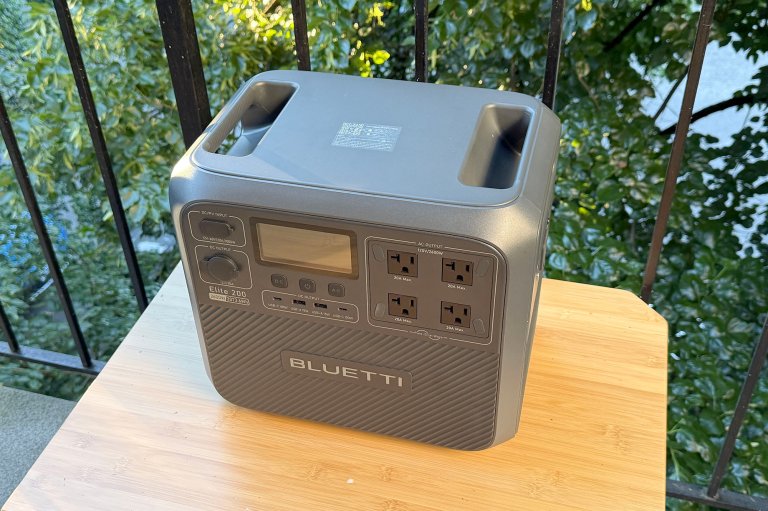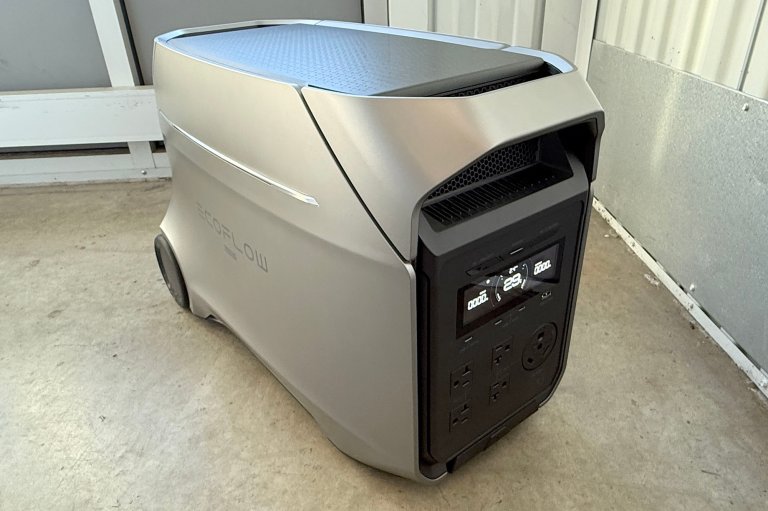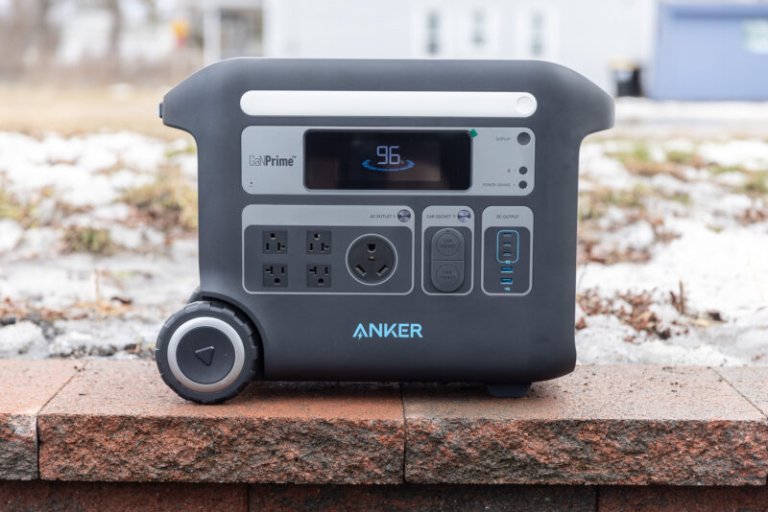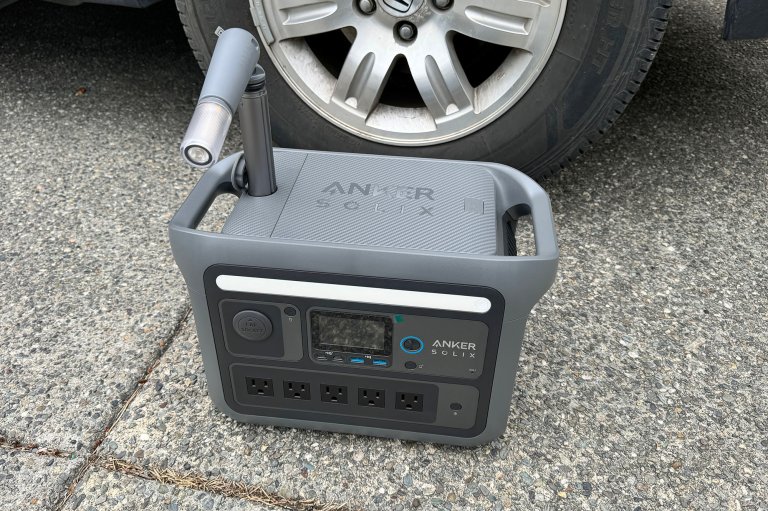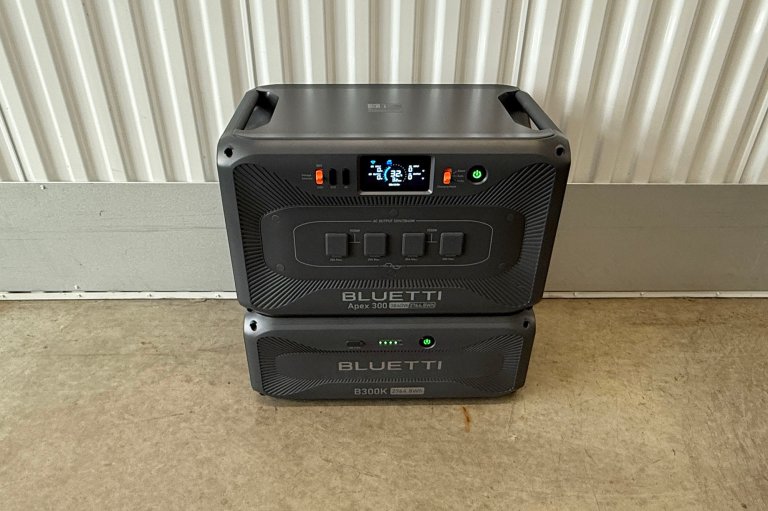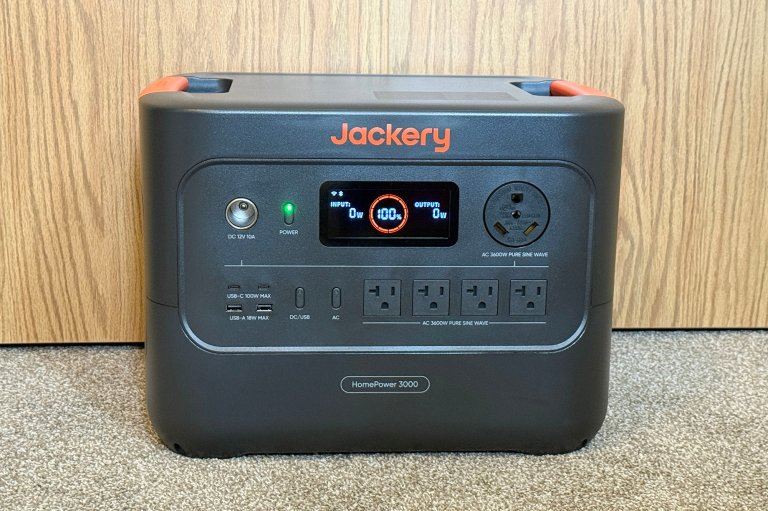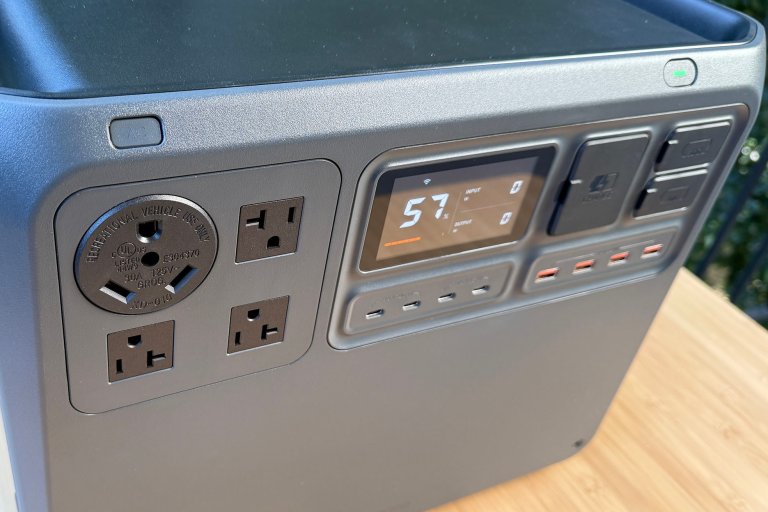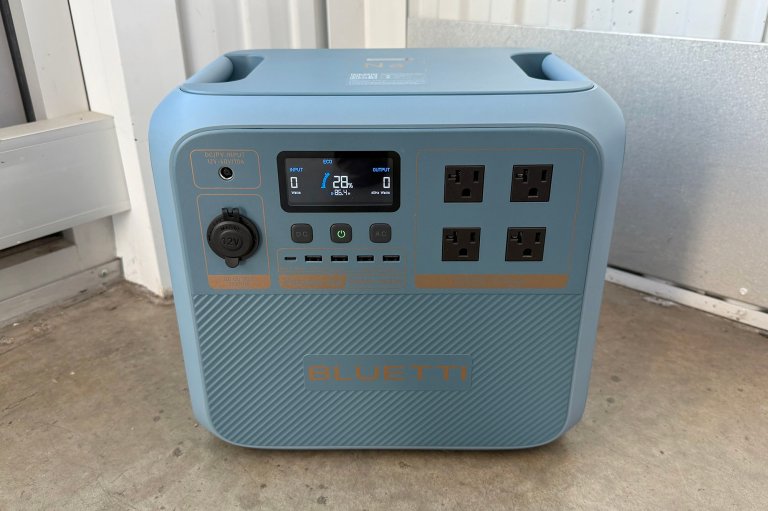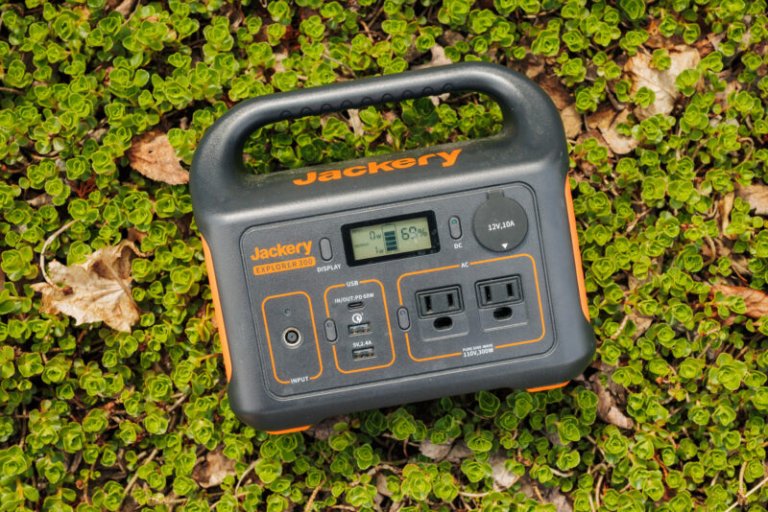We may earn revenue from the products available on this page and participate in affiliate programs. Learn more ›
Solar generators can make your life a little easier on a good day or save you on a bad day. These powerful power packs offer huge battery capacity that can fuel large devices and even appliances in a pinch. They’re great in an emergency, but they’re also essential tailgating and camping equipment. We chose the Bluetti Elite 200v2 as our best overall pick, but there are tons of options out there on the market to meet your needs.
- Best overall: Bluetti Elite 200v2
- Still great: Jackery Explorer 2000 Plus
- Best high-capacity: EcoFlow Delta 3 Ultra Plus
- Best for frequent use: Anker 767 Portable Power Station Solar Generator
- Best for camping: Anker Solix C800 Plus
- Best for off-grid living: Bluetti Apex 300
- Best for home backup: Jackery HomePower 3000
- Best for lots of ports: DJI Power 2000
- Best for extreme cold: Bluetti Pioneer Na
- Best budget: Jackery Explorer 300
How we chose the best solar generators
As an avid outdoorsman, I’ve had the opportunity to test an extremely wide range of outdoor gear, including mobile and off-grid electrification equipment like solar-powered generators, as well as inverter and dual-fuel generators. These became particularly essential when the pandemic forced my travels to become domestic rather than international, which prompted me to outfit a van for long-term road-tripping.
To bring my work along for the ride, I needed a constant portable power source to charge my laptop, a portable fridge, lighting, and a myriad of devices and tools … even electric bikes. As a result, I’ve tried all the leading portable power stations (and plenty that aren’t leading, too), so I know precisely what separates the best from the blah. I’ve written all about it (and other outdoor tech) for publications, including the Daily Beast, Thrillist, the Manual, Popular Science, and more. There were cases when my own opinion resulted in a tie, and I, therefore, looked to reviews from actual customers to determine which solar generators delivered the most satisfaction to the most users.
When to buy a solar generator
If you’re thinking about dropping big money on a solar generator, consider shopping on big shopping holidays like Amazon Prime Day or Black Friday. These are expensive devices, and they experience their largest discounts around those times. That said, they’re rarely the full prices below, even when it’s not a retail holiday, so click through to find out.
The best solar generators: Reviews & Recommendations
The solar generators on this list span a wide range of budgets, from a few hundred dollars to a few thousand. They span several use cases, from camping to a backup for your home. Only you know all the factors that make one of these the best solar generator for you, but we think that one of these will get the job done.
Best overall: Bluetti Elite 200 v2
Pros
- Exceptionally portable
- High output
- Plenty of ports
- Sleek design
- Excellent build quality
- One of the most usable apps out there
Cons
- Not large enough for RV or whole home backup
- A few pounds heavy for its size
Specs
- Storage capacity 2,073Wh
- Input capacity 1,800W
- Output capacity 2,600W (3,900W surge)
- Dimensions 13.8 × 9.8 × 12.7 in
- Weight 53.4 pounds
- Price $1,699
Why it made the cut: No other solar generator delivers such an excellent balance of portability, capacity, and performance.
There are a lot of excellent solar generators on this list, many of which are competitive rivals for the top spot, but none offer such an excellent fusion of capacity, portability, and well-considered design as the Bluetti Elite 200 v2. With a capacity of 2,073 watt-hours, it hits the sweet spot that will deliver on the needs of the vast majority of users.
At the same time, with its just-over-shoebox dimensions and relatively light weight, it’s as portable as can be. This makes it the perfect pick for packing in a trunk while heading outdoors, storing in a closet for backup power, or simply having around for a convenient, mobile power source.
It also offers surprisingly oomphy output for a power box of its size. Its 2,600W running output was already hefty enough, but surge capacity up to 3,900W means it can handle the startup draw of larger electronics and appliances. Its 1000W solar input capacity equips it for a large solar panel array, and its 1,800W wall input capacity will charge from zero to full in just over 90 minutes.
While power station apps are notoriously glitchy, the Bluetti app is user-friendly and allows for remote monitoring and adjustment. Most users will find it has plenty of ports, including four AC ports, USB-A and USB-C ports, and a 120W car port, though there is no 30A or 50A RV plug.
I’ve found that its perfectly squared off design is ideal for fitting into a tight storage space or building into a small van conversion. The LiFePO4 battery has a lifespan of over 6,000 cycles, and the whole unit feels plenty durable. Indeed, I have knocked my test unit around more than a little. It seems no worse for wear.
For most mid-sized portable power purposes, the Bluetti Elite 200 v2 does pretty much everything right.
Still great: Jackery Explorer 2000 Plus
Pros
- Charges quickly
- Very high output that can run power-hungry devices
- Built-in wheels and handle
- Clear display
- Four AC outlets
- Expandable with extra batteries
- Long life batteries
Cons
- Heavy
- Slightly less capacity than our previous pick
Specs
- Storage capacity 2,042.8Wh (expandable up to 24,000Wh)
- Output capacity 6,000w
- Dimensions 18.6 x 14.7 x 14.1 inches
- Weight 61 pounds
- Price $1,999
Why it made the cut: It offers just about everything you’d want, with the added benefits of LiFePO4 battery power.
As new solar generators hit the market, many come toting new lithium iron phosphate (LiFePO4) batteries instead of the familiar lithium-ion batteries that came before. LiFePO4 offers a few advantages, including a much longer lifespan as you charge and discharge them. They’re also safer and often faster to charge. They do typically add some weight, however. Just about all of those modifiers apply here in the form of our former best overall, the Jackery Explorer 2000 Plus.
The Jackery Explorer 2000 Plus can power current-hungry devices at up to 6000W, so even if you want to power a welder, you can. The battery will only last you about half an hour doing this (we tried it), but it does work, and that’s more than many other models can say. I also got to test the Explorer 2000 Plus during a real power outage. It kept our router running for several hours to maintain connectivity.
This model has 2kWh of storage built in, but you can expand that capacity with extra external daisy-chained batteries. It gives a total max storage of up to 24kWh—enough for a serious off-grid job. The optional solar panels charge the battery quickly and efficiently. Jackery claims roughly two hours of charging time via the optional solar panels, and I found it took more like 2.5 hours, but that includes battling some passing clouds. With two straight hours of direct sun, it could likely get the job done.
At 61 pounds, this is considerably heavier than the Jackery Explorer 2000 Pro, which weighs nearly 20 pounds less. But the integrated wheels, handle, and chunky grips on either side of the box make it very easy to lug around. Everyone in my family could easily set it in the back of my wife’s Honda Civic.
The switch to LiFePo4 also means that this unit will last a long time before the battery degrades beyond its usable range. The company claims it will take 4,000 cycles before the battery life degrades to 70 percent. We obviously haven’t had time to test that yet, but that is the nature of LiFePo4, so it will almost certainly last longer than a lithium-ion model at least.
Best high-capacity: EcoFlow Delta 3 Ultra Plus
Pros
- High capacity and expandable
- High output
- Super fast charging
- Love the smart design features
Cons
- Heavy
- Pricey, especially with expansion batteries
Specs
- Storage capacity 3,072Wh (expandable up to 11KWh)
- Input capacity 1,800W
- Output capacity 3,600W (4,600W X-Boost, 7,200W surge)
- Dimensions 24.14 x 12.9 x 15.5 in
- Weight 74.2 pounds
- Price $1.599
Why it made the cut: The EcoFlow Delta 3 Ultra Plus itself is high-capacity, high-output, and exceptionally well-designed, and can expand as much as you need it to.
The EcoFlow Delta 3 Ultra Plus is a solid contender for “best overall,” and the only reason it didn’t get it is because it’s more of a power station than most people need. But if you do need more power station, it delivers.
The standalone unit’s 3,072Wh capacity is plenty for powering an RV or van conversion, an off-grid worksite, or a home during a blackout. 3,600W output is more than enough to power an average assortment of devices, small, and even larger appliances, the X-Boost allows it to temporarily up its running wattage to 4,600W, and its 7,200W surge capacity means it can handle spikes in draw from an AC, appliance, or power tool switching on. Its six charging options allow you to top it off lightning quick—as fast as 89 minutes if you’re readying for a storm or trip—and Storm Guard Mode will monitor the weather and charge the unit automatically if severe weather is coming.
All that’s great, but what I really like about it is how much consideration went into various design elements. For example, whoever thought of having the rear port doors slide into protective slots is a genius. It’s a heavy unit, but the sturdy handle and telescoping wheels make it easy to move around. It’s equipped with a 30A outlet so it can plug directly into an RV, and a good number of other ports.
Excellent all around. If you need a larger, potentially expandable solar generator that offers a good dose of portability, it can’t be beat.
Best for frequent use: Anker 767 Portable Power Station Solar Generator
Pros
- Charges up to 80% in less than two hours
- Solid output and storage capacity
- Optional battery pack doubles capacity
- LiFePO4 batteries survive more charge cycles than traditional models
- Plenty of ports
- Built-in handle and wheels for transport
Cons
- Heavy for its capacity
- No USB-C in for charging
Specs
- Storage capacity 2,048Wh
- Input capacity 1440W Max (1000W Max Solar)
- Output capacity 2,400W
- Dimensions 20.67 x 9.84 x 15.55 inches
- Weight 67.3 pounds
- Price $1,999
Why it made the cut: High capacity and fast charging make this long-lasting battery a solid everyday driver.
Anker has equipped its massive portable power station with LiFePO4 batteries, which stand up much better to repeat charging and discharging over the long term than common lithium-ion cells. Anker claims it can charge and discharge up to 3,000 times before it reaches 80% battery health compared to 500 in a similar lithium-ion setup. While I haven’t had the chance to run it through 3,000 cycles, LiFePO4 batteries have a well-earned reputation for longevity.
Regarding overall performance, the Anker 767 does everything you’d want a unit with these specs to do. The bad weather has given me [Executive Gear Editor Stan Horaczek] ample chances, unfortunately, to test it in real-world situations.
The built-in battery offers a 2048Wh capacity and pumps out up to 2,400W. It does so through four standard AC outlets, an RV outlet, two 120W car outlets, two 12W USB-A ports, and three 100W USB-C ports.
I used it during a blackout to keep our Wi-Fi running while charging my family’s devices. Filling a phone from zero barely makes a dent in the power station’s capacity, and it ran the router for several hours with plenty of juice left.
In another instance, it powered our small meat freezer for four hours before the power came back on with some juice still left in the tank. It does what it promises.
There are a few nice extra touches as well. Built-in wheels and an extendable handle allow it to roll like carry-on luggage. Unfortunately, those are necessary inclusions because it weighs a hefty 67.3 pounds. It’s manageable but definitely heavy compared to its competition.
The Anker 767 is compatible with the company’s 200W solar panels, which fold up for easy transportation. I mostly charged the unit through my home’s AC power, a surprisingly quick process. The 767 Portable Power Station can go from flat to more than 80% charge in less than half an hour with sufficient power. It takes about two hours to get it fully juiced.
Anker also offers a mobile app that connects to the power station via Bluetooth if you want to control it without actually going over and touching it.
Best for car camping: Anker Solix C800 Plus
Pros
- Very compact
- Good capacity and output
- Variable-setting camp lamp
Cons
- Way too small for RV needs
Specs
- Storage capacity 768Wh
- Input capacity 1,440W
- Output capacity 1,200W (1,600W surge)
- Dimensions 14.61 x 8.07 x 9.96 in
- Weight 24 lbs
- Price $649.99
Why it made the cut: Thanks to its small size, decent specs, fast charging, and innovative lantern, it’s perfect for camping.
Say you need a solar power generator for a few days of camping, over the course of which you’re hoping to power a few small devices, a string of lights, and maybe even a small electric cooler—the Anker Solix C800 Plus is the perfect little unit. About the size of a shoebox and just 24 pounds, it’s as portable and compact as can be. At the same time, the 768Wh capacity and 1,200W output are surprisingly good for such a small box. And with a 300W solar panel and good sunlight conditions, it can charge in about three hours.
All good stuff, but what really sets it apart is the integrated lamp, which attaches magnetically and then hides away in the body of the unit when not in use. It has three light modes and makes for an excellent addition to any campsite.
Still good for van-living: Goal Zero Yeti 1000
Pros
- Highly portable
- Incredible durability
- Rapid recharge rate
- Plenty of plugs
Cons
- Expensive for its size/capacity
Specs
- Storage capacity 983Wh
- Input capacity 600W
- Output capacity 1,200W (2,400W surge)
- Dimensions 9.86 x 15.25 x 10.23 inches
- Weight 31.68 lbs
- Price $1,198.95
Why it made the cut: Thanks to its outstanding portability, high storage capacity, and Yeti’s famous durability, the Goal Zero Yeti 1000 Core is great for packing along for camping or van-living.
Yeti is long-renowned for making some of the best outdoor gear money can buy, so when the company launched its Goal Zero line of solar generators, it was no surprise that they turned out to be awesome. While the whole line is great, the 1000 Core model’s balance between capacity and portability makes it perfect for taking on the road and going camping.
While the 1000 Core has a third less capacity than our top pick, it charges up faster, making it a great option for rapid solar replenishment. That said, its capacity is no slouch, offering 82 phone charges, 20 for a laptop, or upwards of 15 hours for a portable fridge (depending on wattage). Suffice to say, it’s more than capable of powering your basic camping gear.
Beyond its charging capabilities, the Goal Zero 1000 Core excels at camping thanks to its hearty build quality. Built super tough—like pretty much everything Yeti makes—its exterior shell provides solid protection.
The biggest issue it presents is the cost. Like pretty much everything Yeti produces, its price tag isn’t small. While there are other 1000-level solar generators for less, this one offers a great balance of power storage and portability.
For more on the Goal Zero Yeti 1000 Core, check out our full review.
Best for off-grid living: Bluetti Apex 300
Pros
- One of the largest expansion capacities out there
- Huge input/output rates
- SolarX accessory is a solar game-changer
Cons
- Very expensive
- Very heavy
Specs
- Storage capacity 5,529.6Wh (expandable up to 58KWh)
- Input capacity 1,800W (expandable up to 30KW)
- Output capacity 3,800W (expandable up to 11.5KW)
- Dimensions Inverter 20.67 × 12.87 × 12.6 in / Battery 20.67 x 12.87 x 8.23 in
- Weight Inverter 83.78lbs / Battery 65.4 lbs
- Price: $3,499
Why it made the cut: Huge expandability, excellent performance, and unsurpassed solar capability make the Bluetti Apex 300 a must for reliable off-grid power.
Bluetti’s Apex 300 does everything you can find in the best off-grid solar generators, then takes it a step further. It has huge storage capacity that gets bigger and bigger depending on your needs (and budget—all those batteries certainly aren’t cheap). You can scale up its output wattage to handle pretty much anything you throw at it. While it’s definitely very heavy, once you’ve got it in place, it’s also very intuitive to operate.
But where the Apex 300 truly excels is in its solar input capacity. Its standard dual 1,200W solar input is already great in its own right, but when you add on the SolarX 4K, it boosts that solar input to 4,000W. When chained with multiple SolarX, Apex, and battery units, it jacks up the input as high as a whopping 30,000W. That’s serious solar capability meant for an equally serious solar array, used by serious off-grid enthusiasts.
Best for home backup: Jackery HomePower 3000
Pros
- ZeroDrain ensures it works when you need it
- Excellent capacity
- Very compact
Cons
- Pricey
- Somewhat heavy
Specs
- Storage capacity 3,072Wh
- Input capacity 1440W
- Output capacity 3,600W (7,200W surge)
- Dimensions 16.4×12.8×12 in
- Weight 59.52lbs
- Price $2,499
Why it made the cut: Great specs and portability, plus Jackery’s ZeroDrain reliability, make the HomePower 3000 a safe bet for outages.
From my experience, the most important thing you need from a solar generator for home backup is reliability. I’ve been disappointed more than once to find that my power station hasn’t held its charge while in storage. To that end, the Jackery HomePower 3000, equipped with its ZeroDrain tech, ensures that you have power when you need it. The HomePower series is a new divergence from Jackery’s already popular Explorer series, and it moves the brand forward in terms of offering not only the aforementioned ZeroDrain, but an improved size to capacity to performance ratio.
Slightly smaller and lighter than Jackery’s Explorer 2000 Plus, it nevertheless has 1,000Wh more capacity, and it’s significantly smaller than the 3000 Pro while delivering comparable capacity and performance. That, combined with its ZeroDrain shelf life, makes it ideal for burying in the closet or garage for a rainy day.
Fastest charging: EcoFlow Delta 2 Max
Pros
- Very fast charging over solar or mains
- Relatively compact
- Not as heavy as we might have expected
- Long-lasting batteries
- Scalable by connecting two extra batteries
- Advanced temperature management for safety
Cons
- Solar panels are pricy
- Still heavier than non-LiFePo4 models
Specs
- Storage capacity: 2048Wh (expandable to 6,000Wh)
- Output capacity: 3,400W
- Dimensions: 19.8 x 9.5 x 12.01
- Weight: 50.71 lbs
- Price: $2,000
Why it made the cut: Whether it’s solar or AC power, you can get 80% of a charge in an hour or less.
Plug this 2048Wh battery pack into up to 1,000 watts of solar panels, and you can get an 80 percent charge in just 43 minutes. That’s blisteringly fast compared to other models. Plug the unit into the wall and you’ll go from zero to 80 percent in just 1.1 hours, which is still fairly speedy when it comes to soaking up electricity. That extra time can make a huge difference if you only have limited opportunities to top off your solar generator. We managed to get above 80 percent in just under an hour without perfect sun conditions here in Upstate New York.
In addition to its quick charging skills, the EcoFlow Delta 2 Max offers an impressive array of connectivity, including six AC outlets, which is more than many larger models offer. That’s good if you want to run many devices or chargers simultaneously. If you need more capacity, you can add two extra external batteries to give it a total storage of 6Wh.
At 51 pounds, this isn’t the lightest solar generator in its category, but like the other EcoFlow generators, it has chunky handles on top that make it easy to lug around. Everyone in my family could easily get it in and out of the back of our Honda CR-V without issue. It doesn’t have wheels, though, so you will have to actually carry it around or put it on a cart.
Ultimately, this feels like a very high-end device. The fast charging is wonderful. The display is clear and relatively bright (though it could be brighter). And it offers a wide array of connectivity.
Best for lots of ports: DJI Power 2000
Pros
- Plenty of ports for phones, drones, and devices
- Output packs a punch
- Good portability
Cons
- Subpar battery lifespan
Specs
- Storage capacity 2,048Wh
- Input capacity 1,800W
- Output capacity 3,000W
- Dimensions 17.6 x 8.9 x 12.8 in
- Weight 48.5lbs
- Price $1,299
Why it made the cut: If you have an abundance of devices to charge, the DJI Power 2000 offers ports galore and excellent performance to boot.
If you tend to use a lot of drones, cameras, and other equipment for content creation or whatever reason, it’s not uncommon to run into issues charging everything at once. The DJI Power 2000 offers a solution in the form of four AC, four USB-A, and four USB-C ports, plus a 30A plug, all backed by 3,000W of running wattage, meaning it packs plenty of power for simultaneous charging. Its 2,048Wh capacity will charge a phone over 100 times, a laptop over 15, a drone over 20, or power a photography lighting setup for over two hours. Its compact size and relatively light weight also make it decently portable.
Its only real drawback is the somewhat subpar battery lifespan. Its capacity drops to 80% after 4,000 charging cycles, versus the 6,000 cycles offered by most leading brands. But if your priority is plenty of simultaneous charging power, it delivers.
Best for extreme cold: Bluetti Pioneer Na
Pros
- Cold weather performance and storage
- Fast charging
- Good output wattage
Cons
- Sodium chemistry means it’s slightly larger and heavier than its lithium counterparts
Specs
- Storage capacity 900Wh
- Input capacity 1,900W
- Output capacity 1,500W (2,500W surge)
- Dimensions 13.4 x 10 x 12.5 in
- Weight 35.3 lbs
- Price $1,299
Why it made the cut: Its innovative sodium battery—the first of its kind—allows the Bluetti Pioneer Na to operate and store at lower temperatures than any other model.
Bluetti has been making some of the best lithium-ion batteries out there, and now they’ve changed the game by releasing the first-ever sodium-ion solar power generator. Typically, power stations operate poorly in cold temperatures, and store in the cold even worse. The Pioneer Na, however, can charge as low as 5 degrees, discharge as low as -13, and store reliably as low as -20. That’s a huge improvement on lithium-ion, which can’t really be used at all below 4 degrees.
At the same time, the performance is good. While the 900Wh capacity isn’t massive, it’s plenty for smaller-scale uses like camping or short-term backup power during an outage. And the 1,500W output is more than enough to power a fridge, TV, and a handful of devices at once. I’m also a big fan of its zippy charging, as it will race from zero to full in as few as 45 minutes. For weathering the cold, there literally is no competition.
Best budget: Jackery Explorer 300
Pros
- Affordable
- Durable
- Portable
- Reasonable capacity
Cons
- No flashlight
- Slower input capacity
Specs
- Storage capacity: 293Wh
- Input capacity: 90W
- Output capacity: 300W (500W surge)
- Dimensions: 9.1 x 5.2 x 7.8 in
- Weight: 7.1 lbs
- Price: $250
Why it made the cut: With its reasonable capacity, compact size, and solid build quality at a low price, the Jackery Explorer 300 is a great budget pick.
Though it isn’t quite as impressive as our top picks for best overall and best high-capacity, Jackery’s smaller Explorer 300 solar generator is super compact and lightweight with a decent power capacity for its price. Less a mobile power station than an upscale power bank, the 7-pound Jackery Explorer 300 provides plenty of portable recharges for your devices when you’re camping, on a job site, driving, or just need some power and don’t have convenient access to an outlet. Its modest 293Wh capacity isn’t huge, but it’s enough to provide 31 phone charges, 15 for a camera, 6 for the average drone, 2.5 for a laptop, or a few hours of operation for a minifridge or TV. A built-in flashlight would have upped its camping game somewhat, but at $300 (and often considerably less if you catch it discounted), this highly portable little power station does a lot for a little.
We tested this portable power station for several months, and it came in handy numerous times, especially during the winter when power outages abound. At one point, we had it powering two phones, a MacBook, and a small light.
The built-in handle makes it very easy to lug around. It feels like carrying a lunchbox. The screen is easy to read, and the whole package seems fairly durable. Our review unit hasn’t taken any dramatic tumbles yet, but it has gotten banged around in car trunks, duffel bags, and other less-than-luxurious accommodations with no issues. If you catch one of these on sale, get it and stick it in a cabinet. You’ll be extremely glad to have it around when the need arises.
What to consider before buying the best solar generators
Over the past few years, solar generators have exploded onto the market. There are now dozens of different brands that largely look more or less the same at a glance. The fact is, there are only a few standouts amidst a sea of knockoffs. Here’s what to look for to ensure you’re getting a great one:
How much power can it store?
A portable solar generator comes in an extremely wide range of sizes, but a generator’s size doesn’t automatically make it capable of storing a lot of power. In fact, most are disappointingly limited and unable to store much more juice than a portable charger.
To properly check a generator’s storage, you must look at its capacity, measured in watt-hours (Wh). One watt-hour is the equivalent of 1 watt flowing over the course of an hour. The best solar generators offer capacities of several hundred and sometimes several thousand watt-hours. That doesn’t mean, however, that it will provide power for several hundred or several thousand hours. Any generator will ultimately last a different amount of time, depending on what’s plugged into it.
It’s easy to predict how long a generator will last when you use it to power one thing. For example, if you were to power a 100-watt bulb using a power station with a capacity of 500 watt-hours, it would stay lit for five continuous hours. Add a portable fridge that requires 50 watts per hour, your phone, which uses 18, a mini-fan that uses three … you get the picture. The more capacity, the better.
Charging capability
No solar generator will hold a charge forever, so you want one capable of charging as quickly and easily as possible. This is where we put the “renewable” into “renewable energy.”
All of the power stations included in this roundup can be charged by connecting them to solar panels (hence the designation “solar generators”). Still, you also want to look for the ability to charge via other sources like wall outlets and your vehicle’s 12-volt plug. This ensures that you can charge up whether you’re off-grid in the sun, plugged in while preparing at home, or using your dash socket on the go.
You must also monitor a model’s charging input capacity, measured in watts (W). For example, a solar-powered generator with a max input of 100W can take in a continuous flow of up to 100 watts, which is about the minimum that you’ll reasonably want to look for. Most of the generators below have input capacities of at least a few hundred watts when charging via solar, so a few 50- to 200-watt solar panels will max them out.
Output capability
Solar generators need to keep the power coming in and going out. The best solar generators can simultaneously charge all your intended devices via whatever plugs are necessary.
Any portable power station worth your money will have a high output capacity so you can charge many devices, even if they require a lot of juice. A generator’s maximum output should be much higher than its max input. While a particular model might only be capable of taking in a few hundred watts at any given moment, it will usually put out exponentially more. At a minimum, you’ll want a generator that can put out 300 watts at a time, though you’ll want at least 500 for larger tasks.
The best solar generators should also offer a variety of output plugs, including AC outlets, USB-A, USB-C, and even 12-volt DC outlets like the one in your vehicle dash. This ensures you can charge several devices simultaneously regardless of their plug. The number of ports you’ll need will vary depending on how many devices you need to power, but it should have at least a couple of AC outlets and a few USB-A ports.
Portability
While portable battery sources have been around for a while now, over the past several decades, they’ve been pretty heavy, unwieldy things. One of the most exciting aspects of the latest generation of solar generators is that they’ve become much more physically compact.
Suppose you plan on taking a generator camping or working it into a van conversion where every square inch matters; well, size and weight become major considerations. All of the products we’ve recommended are about the size of one or two shoeboxes—three at the most. The lightest is about the weight of a 24-pack of soda, while the heaviest is 100 pounds. Most fall somewhere between 30-60 pounds.
If you’re using your generator as a more or less stationary source of backup power at home, portability isn’t a huge issue. Still, we generally recommend keeping weight and size in mind; You never know when you’ll need it for something other than a backup. (Plus, who wants to lug around something heavy and awkward if they don’t have to?)
Another consideration regarding portability involves the necessity for accessories, which can impact how easy it is to move and use your generator. Some generators, for example, require a lot of removable battery packs, which can be a hassle when you’re on the go or packing a vehicle. All of the inclusions on our list require some accessories—you can’t get solar power without connecting cables and solar panels—but they work well with minimal add-ons.
Durability
As with any product you expect to last, durability and all-around quality craftsmanship are essential. This is especially true if you plan on lugging your generator around on camping and road trips. Many subpar power stations are made from cheap components and flimsy plastic that doesn’t feel like it will hold up under the rigors of the road.
Durability isn’t something you can determine by reading a spec sheet off the internet. You’ve actually got to take the generator out, use it a bunch, and see how it holds up. I’ve verified the durability of these recommendations via a combination of my own actual field tests and reviews culled from countless real product owners.
Related: Best electric generators
FAQs
It’s easy to underestimate how much capacity you need. A 1,000 watt-hours might sound like a lot, but if you’re going to power a converted van with a portable fridge, lights, and occasional phone and laptop top-off, that 1,000 watt-hours will go faster than you expect. I used a setup like this and know from personal experience that you should always overestimate how much power you’ll need.
A generator with a capacity under 1,000Wh can keep electronics charged. A larger one with 1000-1500Wh should be the minimum for road trips where you’ll need it to last multiple days between full charges. For a house or worksite where you expect to use some serious energy—like a full-sized refrigerator or power tools—you’re going to want to start looking at the biggest possible power stations that can be daisy-chained to external batteries.
If you want to get precise, there is an equation:
1. Estimate how many hours you’ll need to power various devices. For example, if you want to power two light bulbs for 2 hours: you need 4 hours of operation.
2. Add up the total wattage necessary: the two bulbs are 60 watts each, so you need 120 watts.
3. Multiply these together to find the total watt-hours needed: 4 x 120 = 480. So, in this case, you’d need at least a 500Wh solar generator.
That might sound like a lot for two lightbulbs, but remember that, in most situations, you won’t really be powering 60-watt light bulbs for hours on end. You’ll be charging phones and laptops for an hour here or there, cooling a fridge that kicks on and off every once in a while, using power tools in short bursts, and whatnot.
Most modern generators are rated to last upwards of 25 years. The best-designed power stations are pretty sturdy, with few to no moving parts, so they should likely keep kicking for a long time, provided that you care for them properly. I’ve been pretty rough with a few of mine, and they show no signs of stopping.
Yes and no. While it’s absolutely possible to power your house with solar power, you’re unlikely to do so with a portable solar generator unless you use several at once while limiting your power usage. The largest of our recommendations—the EcoFlow Delta Pro—will come fairly close when bolstered with extra batteries. If the power goes out, you’ll be able to keep your fridge cold and use basic electronics for a couple of days without recharging. With quality solar panels, good sunlight, and smart energy usage, your power should theoretically go uninterrupted.
Final thoughts on the best solar generators
- Best overall: Bluetti Elite 200v2
- Still great: Jackery Explorer 2000 Plus
- Best high-capacity: EcoFlow Delta 3 Ultra Plus
- Best for frequent use: Anker 767 Portable Power Station Solar Generator
- Best for camping: Anker Solix C800 Plus
- Best for off-grid living: Bluetti Apex 300
- Best for home backup: Jackery HomePower 3000
- Best for lots of ports: DJI Power 2000
- Best for extreme cold: Bluetti Pioneer Na
- Best budget: Jackery Explorer 300
We’re living in a “golden age” for portable solar generators. When I was a kid, and my family was playing around with solar gear while camping in the ‘90s, the technology couldn’t charge many devices, so it wasn’t all that practical.
By contrast, the solar generators we’ve recommended here are incredibly useful. I’ve relied on them to power my work and day-to-day needs while road-tripping nationwide. They’re also great when the power goes out. When a windstorm cut the power at my house for a couple of days, I was still working, watching my stories, and keeping the lights on.
We haven’t even scratched the surface in terms of the potential offered by portable, reliable, renewable, relatively affordable power. What we can do now is already incredible. The potential for what may come next, though, is truly mind-blowing.
